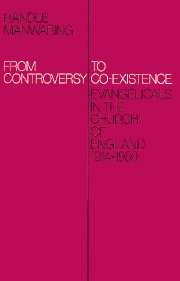Book contents
- Frontmatter
- Contents
- Acknowledgements
- Preface
- 1 Into battle
- 2 The defensive years
- 3 Through the Waste Land
- 4 Continuing nadir
- 5 The turning tide
- 6 Towards the conversion of many
- 7 Flood-tide of Evangelism
- 8 Anatomy of Evangelicalism
- 9 The Fundamentalist issue
- 10 The hard facts of Evangelicals and unity
- 11 The Honest to God debate
- 12 Liturgical debates
- 13 Charismatic differences
- 14 Keele – a watershed
- 15 Evangelical identity – a problem
- Notes
- Index
13 - Charismatic differences
Published online by Cambridge University Press: 18 September 2009
- Frontmatter
- Contents
- Acknowledgements
- Preface
- 1 Into battle
- 2 The defensive years
- 3 Through the Waste Land
- 4 Continuing nadir
- 5 The turning tide
- 6 Towards the conversion of many
- 7 Flood-tide of Evangelism
- 8 Anatomy of Evangelicalism
- 9 The Fundamentalist issue
- 10 The hard facts of Evangelicals and unity
- 11 The Honest to God debate
- 12 Liturgical debates
- 13 Charismatic differences
- 14 Keele – a watershed
- 15 Evangelical identity – a problem
- Notes
- Index
Summary
The 1960s were years of great social change which inevitably influenced the whole Church, not least Evangelicals. There was a kind of freedom in the air and this coincided with a renewal movement in the Church, often labelled ‘charismatic’ in nature. For example (it seemed amazing at the time) there were raised hands in Pentecostal praise at a full house in no less a place than Guildford Cathedral. Drama and dance routines were becoming part and parcel of the new life of Christian faith and worship. In some ways, these new joyous dimensions of worship resulted from the freedom of the whole transdenominational charismatic movement, its spontaneity and youthful lack of inhibition. They may well have been the answer to the Alternative Society, the world of the hippies and the commune and the much greater freedom in resolving the problems of human sexuality. Furthermore, the National Festival of Light's protest against the defilement of public life by pornography and the like brought a crowd of 100,000 to its first rally in Trafalgar Square. The battle lines were being openly drawn between positive Christian standards of morality on the one hand and the world's easy going decadence and promiscuity on the other. There had been a sharp decline in public taste, in what was permissible in the theatre, the screen and literature and the Festival of Light raised the standard against such a fall.
- Type
- Chapter
- Information
- From Controversy to Co-ExistenceEvangelicals in the Church of England 1914–1980, pp. 164 - 173Publisher: Cambridge University PressPrint publication year: 1985



